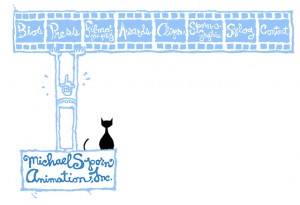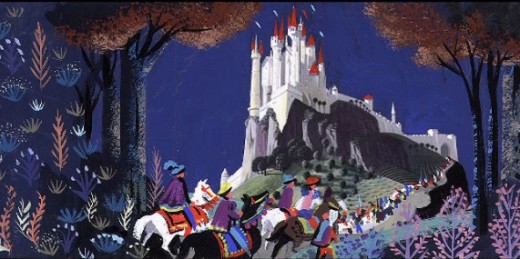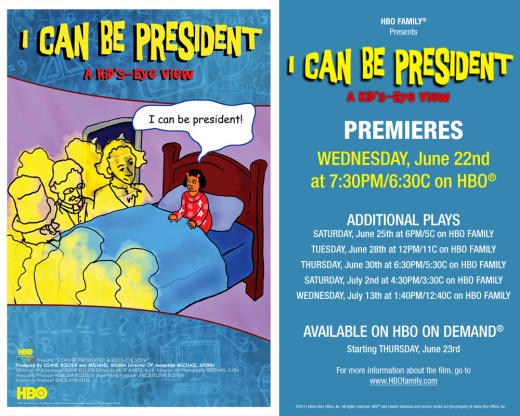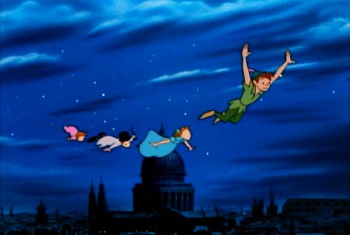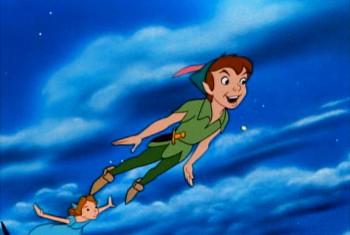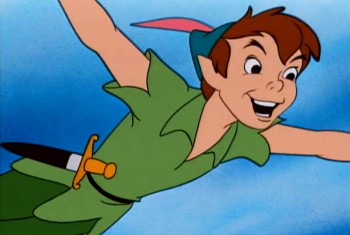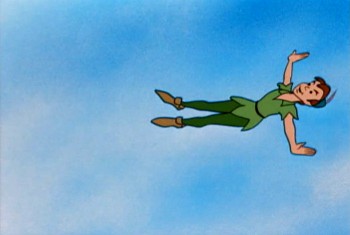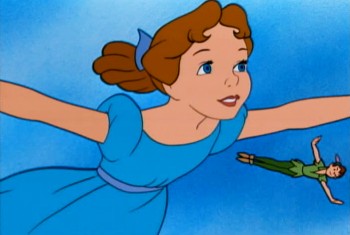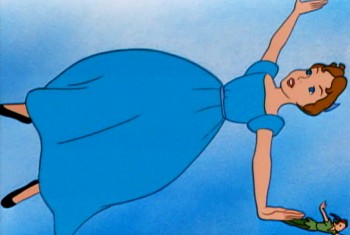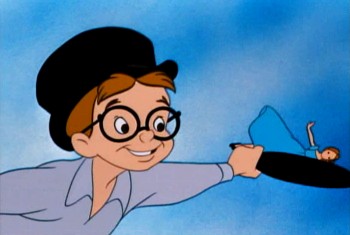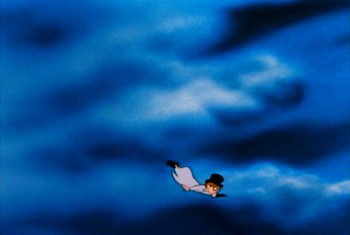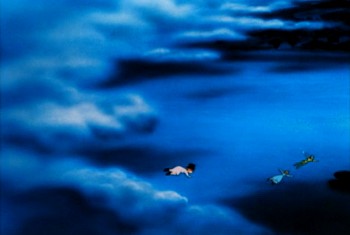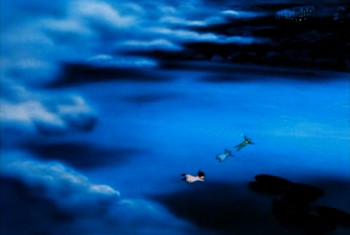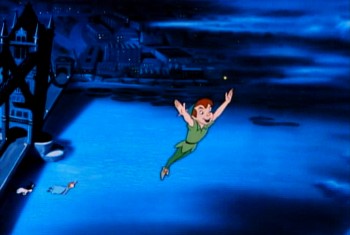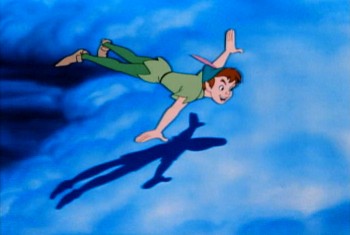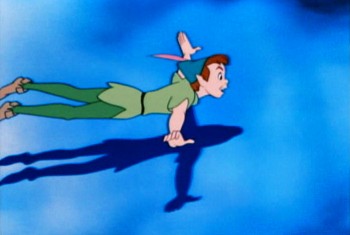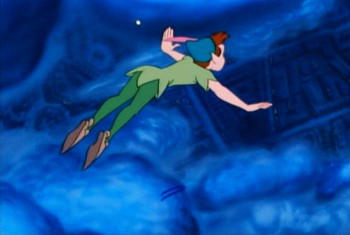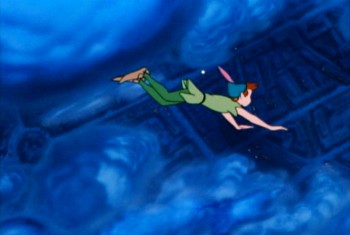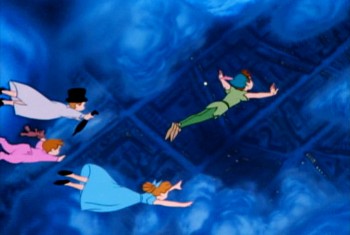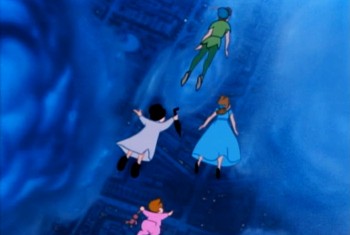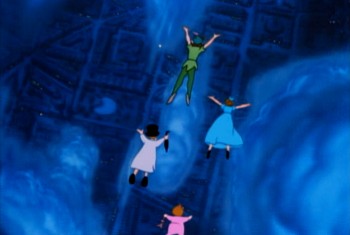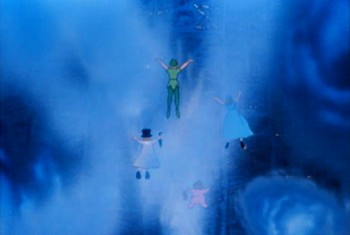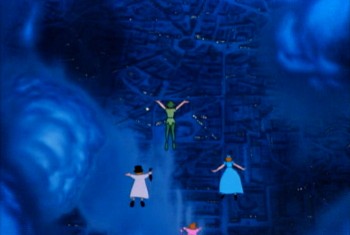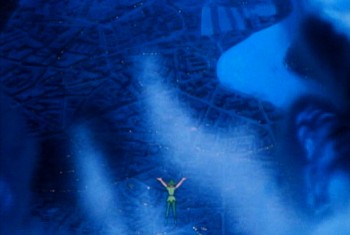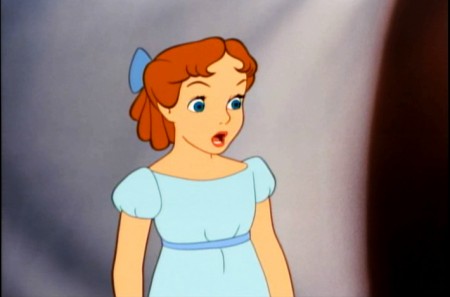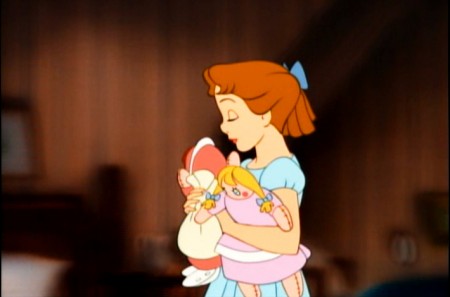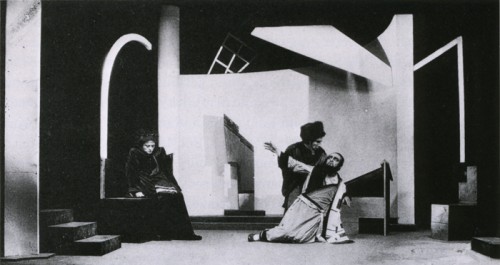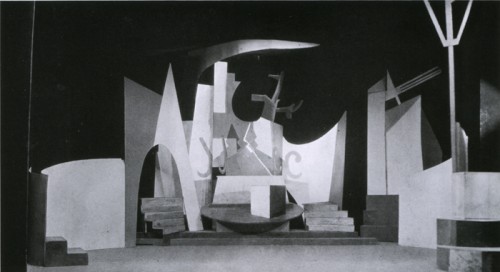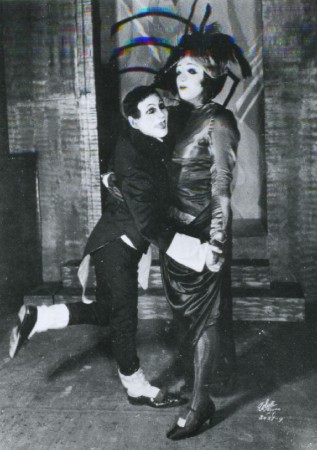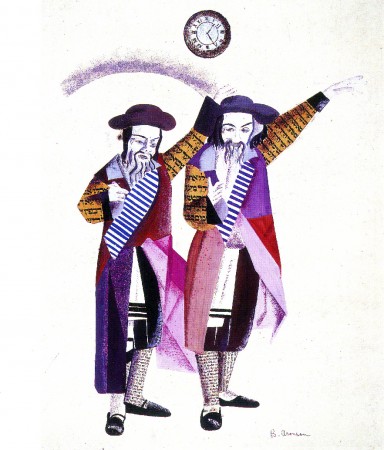Category ArchiveCommentary
Commentary 16 Jul 2011 06:54 am
Classics
A memorial tribute film to Karen Aqua
by Lisa Crafts, music by Ken Field
- Last Sunday, July 10th, Ken Field held a memorial celebration of the life of his wife, the brilliant animator, Karen Aqua, who passed away last May. I wasn’t able to attend the tribute in Somerville, Massachusetts, but I was glad to learn that it was well attended and very much appreciated by those who were able to go. The speakers included Julie Zammarchi, Grey Held, Jeanée Redmond, and others. Ken, of course, had comments of his own which can be found on his Facebook page.
He also has intentions of creating a DVD compilation of Karen’s films and is trying to decide how many to produce. Here’s the note he sent me:
- There have been a lot of inquiries about how people can buy a dvd compilation of Karen’s animated films.
I am in the process of putting together such a dvd, and am arranging for a distributor for it. But it would be helpful to have some sense of how many to initially make.
To that end, I have put together a survey that you can answer online. If you think you might want to buy such a dvd, please go here to fill in the number of copies (1 is a fine answer) that you might want to purchase. The cost will probably be around $20, plus shipping, and the dvd will include all of Karen’s personal animated films, including Afterlife (but not any of her Sesame Street work or any of the workshop films we directed together).
I’ll tally these numbers in a few weeks, and send out a note when it becomes possible to order a dvd.
With all best wishes,
-Ken
The tribute ended with a second line procession that left a sweet note to the sad day.
- I thought it might be useful to point out that on my studio website, MichaelSpornAnimation.com, there is a place where you can see the schedule of Sporn films that are airing or playing around the country. Most often this means an HBO monthly schedule of Sporn films. There are, naturally enough, other goodies on that site.
By the way, I’m pleased as punch to have our most recent film, (an abbreviated version of our HBO show) I Can Be President, selected for competition in the Ottawa Animation Festival. I will be there and hope to see a lot of you there as well.

- I very much like Oscar Solis‘ idea for a new art blog. Covering the Classics is dedicated to his designing book covers for famous classic pieces of literature. Already he has done a number of beautiful illustrations. Kwaidan is beautiful and Moby Dick has strength in its simplicity. I hope he’ll keep it up.
My only complaint is that I wish the original size of the art could be a bit larger so that we can enjoy it a bit more.
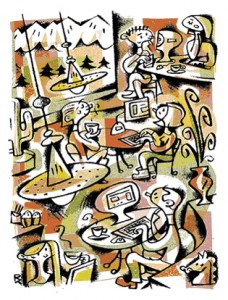
- Robert Kopecky is a designer. He’s designed for quite a few animation shows (Nate the Great, Codename: Kids Next Door, Daria et al.)
He’s created several blogs: one for animation design and another for his overall design. The latter includes a number of illustrations he’s done for publication.
Personally, this is my favorite of all the artwork displayed. There’s a lot of personality in all of this print design. Obviously, with his animation work he’s been given a specific styles to work in, and this reduces the slight edge I find in his illustration. I’d like to see some animation he designs from scratch.
His animation blog can be found here.
His design blog can be found here.
It’s worth keeping an eye on what he’s up to.
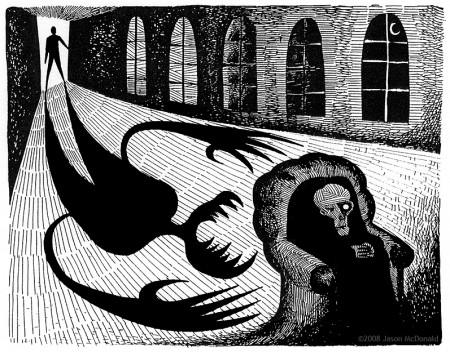
“The Tell-Tale Heart” which was part of the original proposal for the
POE feature we’re doing, but is no longer part of the film.
- And while I’m mentioning blogs of animation designers, I have to plug one who worked for me for years. The brilliant Jason McDonald has two blogs he publishes. One is for his design work, both animation and just-plain-Art, and the other is for a comic strip he does on line, My Living Dead Girl. (It’s a strip about zombies.)
Jason has done a substantial amount of design and storyboard work for my studio over the years (including quite a bit of work on developing some of the stories for the POE feature we’re trying to get going. His artwork is fun to animate and has a real sense of design to it, yet it’s not a look anyone else is doing. It’s original. He also has a great sense of daring in all the backgrounds he’s done for my films. I can’t sing his praises highly enough. As a matter of fact, though I’ve done a post or two about him, I think I probably owe him at least another one. (That way I’ll get some attractive Sporn art on my blog again.)
Champagne Bgs,
Nonsense,
Nonesense and Lullabyes (sic)
Jason’s animation design blog can be found here.
My Living Dead Girl can be found here.

- And I’d also like to give a shout out to Stephen MacQuignon‘s illustration blog. Steve worked with me for a million years coloring many big efforts such as The Red Shoes, The Hunting of the Snark, Whitewash, and Lyle Lyle Crocodile. After leaving my studio, Stephen started illustrating books and has been fairly successful at it. You can see lots of samples on his web site.
Commentary 02 Jul 2011 07:53 am
More Odds & Ends
- A week or so ago Jeff Scher had a new film tha was posted on The NYTimes website. ‘You Might Remember This’ is a piece which focuses on Jeff’s son, Buster. Jeff writes:
 While these films portray childhood, the perspective is parental. If Buster had made this film it would be all baseball, and the actual point of view, looking up at grownups twice his size, would surely feature more chins and nostrils. The angle might seem a small thing, but it can alter the feeling in subtle ways. Looking at children, our perspective is angled down and as they look up, we see eyes, those big ones, looking up like lasers. And, like every portrait, these films are double portraits, simultaneously reflecting the sensibility of who made them as well as who they picture.
While these films portray childhood, the perspective is parental. If Buster had made this film it would be all baseball, and the actual point of view, looking up at grownups twice his size, would surely feature more chins and nostrils. The angle might seem a small thing, but it can alter the feeling in subtle ways. Looking at children, our perspective is angled down and as they look up, we see eyes, those big ones, looking up like lasers. And, like every portrait, these films are double portraits, simultaneously reflecting the sensibility of who made them as well as who they picture. It’s a beautiful piece and well worth viewing. Like many of Jeff’s films, there’s a great score by Shay Lynch. (It’s worth visiting his website, too. He’s writing the score to Paul Fierlinger‘s next feature, Slocum.)
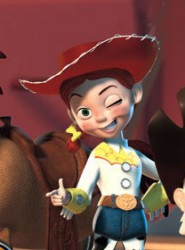 – Remember when Toy Story 3 came out, and the word from Pixar was that this was the last of the series? Now we learn that Tom Hanks has said the Toy Story 4 is in the works. (Will that come before or after Cars 3?)
– Remember when Toy Story 3 came out, and the word from Pixar was that this was the last of the series? Now we learn that Tom Hanks has said the Toy Story 4 is in the works. (Will that come before or after Cars 3?)
Hopefully, the future feature won’t be anything like the horrible little short that’s currently attached to Cars 2 in theaters. That short in combination with the companion feature, for an awfully tedious outing. I guess it’s too hard to pass up the billion dollars they made on the last Toy Story film; and who can blame them. It also received an Oscar and four nominations. Now they have a financial success with Cars 2, and you know the franchise won’t end there. (One wonders after the abysmal critical failure of this recent movie, will Lasseter continue writing and directing the upcoming film, himself?) Let’s hope that Oscar doesn’t fawn over Pixar with this terrible movie as they did with TS3.
Pixar is getting to smell like the Dreamworks of Shrek 4 fame. Anything for a buck – or is it a billion bucks for these things.
 - One more thing I’ve been wondering about Cars 2. John Lasseter not only gets credit for directing (Brad Lewis gets credit as “co-Director”), but he also takes credit for the story along with Brad Lewis & Dan Fogelman. Ben Queen is credited for the screenplay.
- One more thing I’ve been wondering about Cars 2. John Lasseter not only gets credit for directing (Brad Lewis gets credit as “co-Director”), but he also takes credit for the story along with Brad Lewis & Dan Fogelman. Ben Queen is credited for the screenplay.
Now where does the storyboard fall into this schema? How do they work it? Do they write the “Story” first, then do a board changing things and then they write a screenplay from the board? Do they develop the story by doing a storyboard and then the script writer comes in to put down the dialogue? I’m curious as to how Pixar works. How does John Lasseter run Pixar, run Disney and then sit with board artists to construct a convoluted script like Cars 2? I honestly do not know. It sounds like a lot of hard work!
- Bill Benzon has an interesting piece on his blog New Savannah. In it he shows the connection between the 1945 Warner Brother’s cartoon, Book Revue, and the more recent feature-length film, The Secret of Kells (2009).
A site I hadn’t added to my Blog Roll until recently is Alltop. This lists the last five posts of a number of animation and drawing sites. It’s handy to see a large group of sites in a quick viewing to see if there’s anything you’ve missed. I also like seeing my site there on a regular basis.
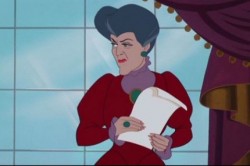 - Grayson Ponti has a blog that is built around the 50 Most Influential Animators in Disney History. There’s a large number of people and their histories to wade through for Mr. Ponti, and it makes for a different kind of blog.
- Grayson Ponti has a blog that is built around the 50 Most Influential Animators in Disney History. There’s a large number of people and their histories to wade through for Mr. Ponti, and it makes for a different kind of blog.
I like that he not only looks at animators of the past but those of the present, as well. I don’t know many from the present and I should, so reading this blog acts like a wonderful crib sheet for me.
However, I wonder if these are the “most influential animators in Disney history” or just the lesser known. Although Mr. Ponti says that he, admittedly, has a hard time just selecting 50, I assume he’s gone over his quota. In a recent post, he does call Hugh Fraser, Don Lusk, Hicks Lokey and others “Honorable Mentions”.
Regardless, this is a fascinating blog and you should check it out. There’s plenty o’ reading here.
Note: The TAG Blog wrote about this last week. Mr. Ponti contacted me a week ago, but the link he sent me didn’t work, and it’s taken me ’til now to be able to get there.
I’m glad I did.
Commentary 25 Jun 2011 08:38 am
Cars & Archie

- Cars 2 doesn’t seem to be getting the magic reviews that Toy Story 3 got.
At least that’s how it looks in New York.
Let’s take a look at a couple of the most obvious reviews.
A.O.Scott in the NYTimes wrote:
- Even without Mater’s nattering . . . “Cars 2†would be, by far, the loudest Pixar feature yet. The whine of engines and the rattle of gunfire (surprisingly frequent in a G-rated film) compete with the nonstop yakking to such an extent that Michael Giacchino’s score has to strain and blare to be heard. Perhaps after the exquisite silences in “Wall-E†and “Up,†the Pixar team wanted to open up the valves, kick up some dust and make some pop culture noise, leaving the poetry to someone else. Or maybe the company was tired of turning out one masterpiece after another and decided to coast for a while.
“Cars 2†is certainly built to move merchandise — this series may surpass even the “Toy Story†films as an effective advertisement for licensed playthings — but it is notably lacking in soul or sublimity. . . It may be intriguing to imagine what our toys do when we leave them behind, but there is something irreducibly grim about an entire planet ruled by mass-produced consumer goods whose producers and consumers are nowhere around.
But maybe I’m misinterpreting the movie and underestimating Pixar’s capacity for subversiveness. Maybe “Cars 2†is a dystopian allegory for an era of ecological anxiety.
Or maybe not.
Joe Neumaier of the NY Daily News was the most positive, giving it three stars:
- With Porsches and Jaguars rolling out of Pixar annually, you can excuse some occasional clank and knock. So “Cars 2″ cruises in looking polished, and if there’s very little under the hood, it’s surely because this savvy and sensitive company has unapologetically made a movie for (very) young moviegoers.
. . . whereas the first movie’s lessons about appreciating a slower pace and the way the world once lived contained Pixar’s trademark subtlety — junior division — the sequel’s message about standing by friends and remaining true to yourself is nice but, well, standard.
Kyle Smith of the NY Post was not as generous giving it 1½ stars:
- They said it couldn’t be done. But Pixar proved the yaysayers wrong when it made its first bad movie, “Cars.” Now it has worsted itself with the even more awful “Cars 2.”
This international toy fair and pun emporium billed as a movie relies painfully on the redneckery of Larry the Cable Guy, an alleged but not proven comedian whose country corn-pone act makes Jeff Foxworthy look like Gore Vidal.
. . . London billboard reading “Lassetyre,” a reference to the film’s director, John Lasseter, looks like a typo. Surely they meant Lassetired?
In much the same way that a pleading nightclub comic might say, “Is anyone here from a foreign country?” “Cars 2″ makes a show of its globalism, zinging around the planet to mollify important markets — sorry, countries!
Things are so dull, rote and humorless that when signboards in a European scene read “Mondiale Grand Prix,” I at first thought they said “Mondale Grand Prix,” which sounds like an unwanted award this movie could easily win.
But then maybe New York isn’t so different from the rest of the country; the film got a 33% on Rotten Tomatoes (not good). I have a free Academy screening coming up next week. I’m not sure if I’ll make it.
The Chuck Jones Gallery, 232 Fifth Avenue, in the heart of San Diego’s famed Gaslamp District will showcase the original drawings of famed Archie’s Comics cartoonist, Henry “Scap” Scarpelli. The show will be on display July 21st through July 24th during Comic Con International.
Henry Scarpelli, a native New Yorker, studied at the School of the Visual Arts in Manhattan and after service in the U.S. Army landed his first job in the art department at General Features, a newspaper syndicate.
“We are thrilled to premiere the Scarpelli Estate’s collection of original Archie Comic’s drawings, both graphite and inked,” said Scott Dicken, vice-president of retail operations for Linda Jones Enterprises, the parent
company of the Chuck Jones Gallery, “from the hand of this master of the comic book panel. Henry Scarpelli’s work is without peer in the field of comedy cartooning.”
I was a fan of the Archie comics when I was younger, but that was in the days of Bob Montana’s handling of the comics. It would be a kick to see the original art for this comic strip, but I’m in New York with no plans t make it to San Diego. If you’re in the area, I’d urge you to check in to see the show.
- Aardman has teamed up with Nokia again. Last year they produced the world’s smallest bit of stop-motion puppet animation. This year they’re trying for the largest. (Something tells me they’ll succeed.) If you want to follow the blog for this project you can go here.
Commentary &Disney 18 Jun 2011 07:34 am
Sight Seeing
- This past week Jonna commented on this blog: I can only imagine how it would have been to see one of the classics at a theater (I was born in the 90’s). It would have been great fun if any of you told about a premiere or screening that you’ve attended (e.g. the first time you saw Sleeping Beauty or something).
So I thought of a couple of memories I have of seeing some of the classic Disney films theatrically for the first time. So kiddies gather round Gran’pa while he tells you a story.
 The first film I’d ever seen was Bambi. I don’t remember much about it, but I’m sure that the experience permeated my brain and sent me on a direction I could never return from. This is still one of my favorite classic Disney films. I’m not big on the cutesy aspects of the movie – specifically the “twitterpated” sequence, but I am big on everything else. Back in those days, there were often Surprise guests coming to the movie theaters to promote the shows. At this one particular event, to celebrate Christmas they drew back the curtain and had a pile of large gifts all wrapped in foil-colored gift wrap. Clarabelle the clown from the Howdy Doody Show was a special guest who was going to give out gifts to the boys and girls in the audience. He went through a short routine which ended with the supposed gift-hand-out. But it didn’t happen that way. Clarabelle took out his bottle of seltzer and started spraying the audience. The blustered theater manager called for the curtain to be closed, and that was that. Even at the age of 4 or 5, I knew we was robbed. No wonder I couldn’t remember much about Bambi.
The first film I’d ever seen was Bambi. I don’t remember much about it, but I’m sure that the experience permeated my brain and sent me on a direction I could never return from. This is still one of my favorite classic Disney films. I’m not big on the cutesy aspects of the movie – specifically the “twitterpated” sequence, but I am big on everything else. Back in those days, there were often Surprise guests coming to the movie theaters to promote the shows. At this one particular event, to celebrate Christmas they drew back the curtain and had a pile of large gifts all wrapped in foil-colored gift wrap. Clarabelle the clown from the Howdy Doody Show was a special guest who was going to give out gifts to the boys and girls in the audience. He went through a short routine which ended with the supposed gift-hand-out. But it didn’t happen that way. Clarabelle took out his bottle of seltzer and started spraying the audience. The blustered theater manager called for the curtain to be closed, and that was that. Even at the age of 4 or 5, I knew we was robbed. No wonder I couldn’t remember much about Bambi.
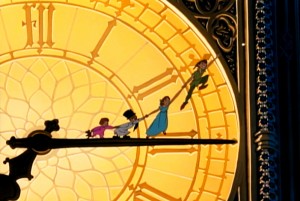 The second film I’d ever seen was Peter Pan. That would have been for the 1953 theatrical release. My father took me to one of those large movie palaces in upper Manhattan, the Loew’s 181st Street. I remember it playing with a film about a jungle cat of some kind; I’ve always remembered this as The Black Cat, but that title isn’t right. So I obviously don’t remember the title of the film, a B&W scary movie.
The second film I’d ever seen was Peter Pan. That would have been for the 1953 theatrical release. My father took me to one of those large movie palaces in upper Manhattan, the Loew’s 181st Street. I remember it playing with a film about a jungle cat of some kind; I’ve always remembered this as The Black Cat, but that title isn’t right. So I obviously don’t remember the title of the film, a B&W scary movie.
Re the animated feature, I remember most the swirls of color of Pan and gang flying; I don’t remember much else about it from that initial introduction. I was absolutely enamored with the moviegoing experience from The Black Cat to the brilliant cartoon. Remember, I was only 6 or 7 years old, at the time.
In 1955, I was in charge of about five kids (a couple of siblings and a couple of cousins) going to a local theater to see the NY premiere of Lady and the Tramp. Back then, it would cost 25 cents for a kid to get into the movies. When we’d gotten to the local movie theater for this film, they’d raised the price to 35 cents – more than our parents had allotted.
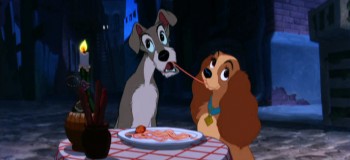 Outside the theater we were counting up our monies and trying to figure out how much we’d need to get in and buy some candy or popcorn for all of us. Within seconds my cousin announced that she’d lost her money, and it was obvious there wasn’t going to be enough for refreshments. The cousin started crying loudly, bawling until the movie theater manager came up to ask what was the problem. She spluttered out the word that she couldn’t afford any candy now that she’d lost the money to get into the movie. The manager just reached into his pocket and gave me an additional dollar. Enough money for movie and candy and more importantly it stopped my cousin’s screaming.
Outside the theater we were counting up our monies and trying to figure out how much we’d need to get in and buy some candy or popcorn for all of us. Within seconds my cousin announced that she’d lost her money, and it was obvious there wasn’t going to be enough for refreshments. The cousin started crying loudly, bawling until the movie theater manager came up to ask what was the problem. She spluttered out the word that she couldn’t afford any candy now that she’d lost the money to get into the movie. The manager just reached into his pocket and gave me an additional dollar. Enough money for movie and candy and more importantly it stopped my cousin’s screaming.
Once inside the theater I ignored them – even though the cousins were badly behaved and squirmed about through most of the show. I liked the film so much that I made the whole group sit with me to watch it a second time. That big, wide Cinemascope screen. It was heaven.
We did this often back then. I remember another time going to see Pinocchio with my younger sister, Christine. We sat through Pinocchio three times before we left the movie theater. That meant we had to sit through the second feature (usually some live action dud) twice to get to the third showing of the cartoon. My sister reminds me often enough that when she turned around she’d seen that the theater was empty except for the two of us. The usher stood in the back giving us the evil eye.
Prior to Sleeping Beauty‘s release, I’d been doing some reading. I’d received Bob Thomas’ The Art of Animation the previous Christmas, and I read it over and over at least a hundred times. I memorized every still in that book and couldn’t wait to get my eyes on Sleeping Beauty.
The film opened at Radio City Music Hall, and I was given permission to make one of my first trips downtown to see the film. An hour subway ride for a 12 year old. I went into this largest of movie theaters in the City, and I picked a great seat. The audience wasn’t overflowing; the show wasn’t sold out. But it was BIG.
The screen is enormous in that theater, and Sleeping Beauty was made to fill such a screen, especially in its Technirama debut. But somehow I came out of the theater disappointed. I don’t know what had gotten into me. I don’t remember any reason for disliking it. As a matter of fact, I absolutely love the film now. Those Eyvind Earle settings; the great animation of Maleficent; the dragon fight. There’s just a million reasons I have for loving it, but something about that first viewing left me cold. And I remember trying to analyze, at the time, what I thought was missing from the experience. I had no answer.
I’ve seen all of the pre-cgi Disney films in theaters. I also remember all the experiences of sitting through them. Dumbo and Alice In Wonderland were the only two that I saw on TV first. They were both special presentations on the Disneyland show. Eventually, I’d see them both in theaters at special screenings.
Of all of them, Dumbo still stands as my favorite though in a close tie to Snow White. There’s something they both have that goes beyond the brilliant animation and the graphics on screen. There’s an emotion there that they both have, not quite an innocence but more like a daring. Without consciously saying it, you felt the Disney people were shouting, “Look what we can do!” And they did do it. (By the time they did Fantasia, they were too conscious of what they could and had done, and they’d lost it – for me.)
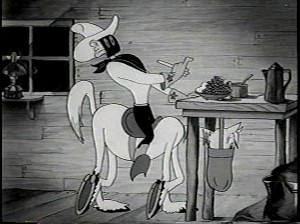 Eddie Fitzgerald is either a genius or a real-life looney toon – who I treasure. Probably, I think both; he’s at least an original. His blog is like no other in that he gives us real deep rooted comedy that makes you laugh aloud. He puts together these photo-montage storyboards creating a wacky movie that you just gotta keep reading, and when he’s on the mark, there’s nothing short of brilliance.
Eddie Fitzgerald is either a genius or a real-life looney toon – who I treasure. Probably, I think both; he’s at least an original. His blog is like no other in that he gives us real deep rooted comedy that makes you laugh aloud. He puts together these photo-montage storyboards creating a wacky movie that you just gotta keep reading, and when he’s on the mark, there’s nothing short of brilliance.
Bob Clampett did a wacky WB short called The Lone Stranger and Porky. Obviously, it was a parody of the big radio show of the time, The Lone Ranger. Well, Eddie takes off on that parody and does Clampett one better. It’s crazy and hilarious and you have to check it out (if you haven’t already.) The Lone Stranger (Parody) via photomontage.
Someone should finance this guy to make a real movie. This artwork would take cgi in a direction that hasn’t been considered before. Maybe then they’d have the first REAL animated cgi film instead of all these cutesy viewmaster things we get.
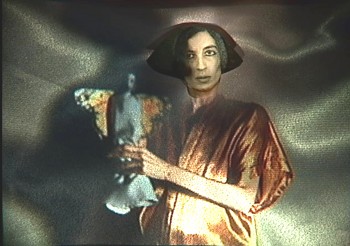 Last week I started a new series that I hope will go on forever. I’ve been interviewing Independent animators, the ones who are trying to make artful animation on their own. They don’t have the dollars that a Dreamworks would, but they’re using all of their resources to make movies that have something to say.
Last week I started a new series that I hope will go on forever. I’ve been interviewing Independent animators, the ones who are trying to make artful animation on their own. They don’t have the dollars that a Dreamworks would, but they’re using all of their resources to make movies that have something to say.
The first post was an interview with George Griffin, who has been something of an inspiration to me. Upcoming this Tuesday will be an in depth look at the amazing career of Kathy Rose. She takes animation, mixes it with dance and Performance Art and comes out with amazingly original work. I’m having a good time putting these pieces together, and there are so many who deserve the attention.
- I have one last bit of self-aggrandizement to post. THis coming Wednesday, June 22nd, HBO will premiere the latest Special we’ve done for them. (Notice how I date myself by calling it a “Special”. That’s what they were called when I was younger. These days I only know the industry word for them, “one offs”. I don’t like to think of my show as a “one off”; it’s a Special.)
The show is about half animated; the other half consists of kids saying the wackiest things. It’s fun. So there you go.
Commentary &Disney &Frame Grabs 13 Jun 2011 06:33 am
Peter Pan Multiplane
- I had remembered Peter Pan as utilizing the multiplane camera quite a bit to set up the show. In the most obvious ways, where I thought they used the camera, I was wrong. There’s, of course, the one famous flying scene with Peter, Tink and the family over lots of clouds. But other shots of London and the opening of the house are not dimensional. They were painted on one level.
In a way, this film, despite the success of Cinderella, is an equally austere production. Gone are the days of Pinocchio and Fantasia where the multiplane camera was enormously effective and often used. Hello to the days of tight budgets.
Let’s take a look.

This is the opening once we hit London (down from a star).
We pan from London to the fog.
No multiplane camera use is evident. It’s a single-level Bg.
Dissolve to
 1
1
The Darling townhouse. Camera trucks in slowly.
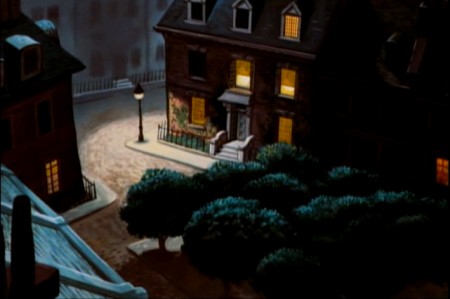 2
2
There are no separate levels, no use of the multiplane.
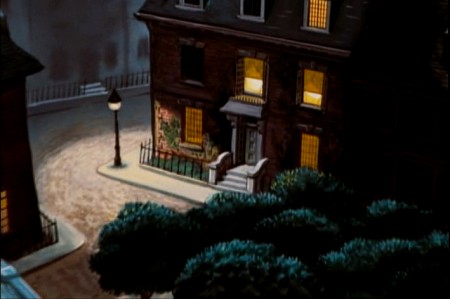 3
3
This is disappointing given how good the similar scene which opens
101 Dalmatians looks using a simple multiplane setup.
Once inside the Darling household there is no obvious use of the multiplane.
The next scene to question starts as Mr. & Mrs. Darling prepare to go off to their party leaving the children behind.
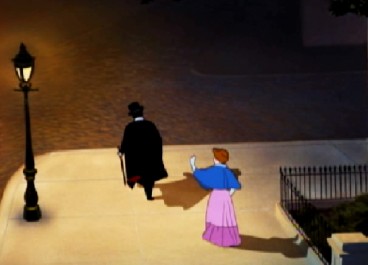
This next pan starts at the base as the Darlings
walk away from the camera into the distance.
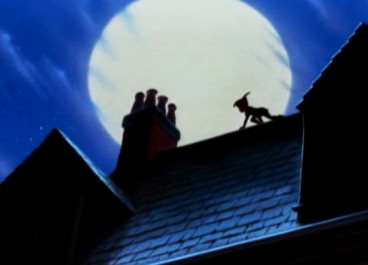
We pan up to the rooftop to see Peter Pan in silhouette.
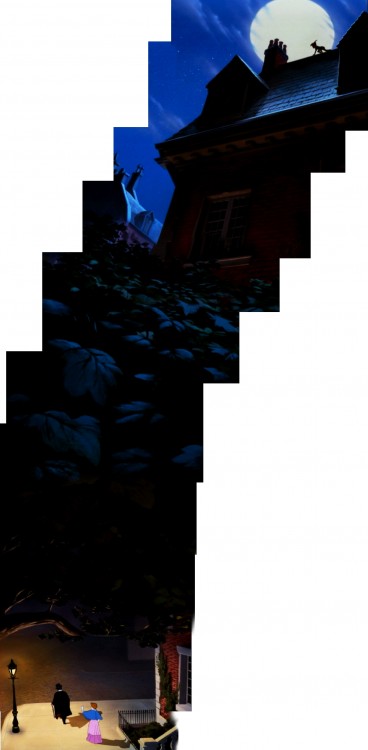
This is the full Bg.
There is no use of the multiplane camera.
Nor are there separate levels – it’s all one piece.
So, it would seem that the multiplane has not been used to this point.
The big flying scene comes just as they’re about to fly out of London and on to Neverland. It serves as the bridge from everyday life on to the magical land of Peter Pan. You need something big here, and they’ve got it – one of the biggest multiplane scenes ever. The layout for this scene is extraordinary, and the animation couldn’t be better. It’s quite a scene.
 1
1We cut from this shot of the clock.
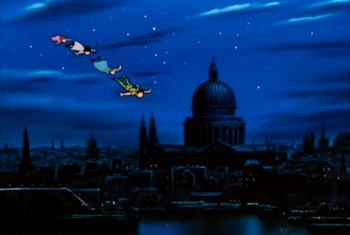 2
2
Peter & gang fly over clouds on flat Bg.
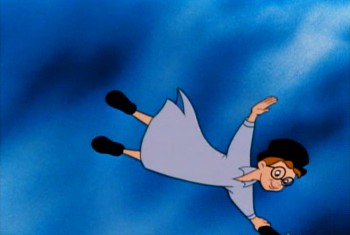 11
11
All done with some brilliant animation.
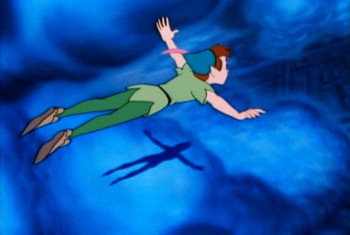 21
21
Suddenly the bottom drops out and it’s multiplane.
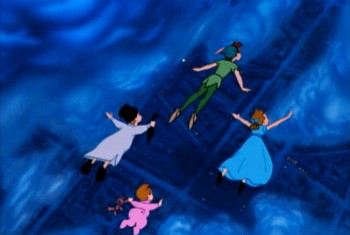 25
25
The camera also turns to have the characters flying North.
 31
31
The camera zooms past them . . .
 32
32
. . . and moves up to star.
There are one or two other small uses of the multiplane camera on Neverland. Typical of these is this shot of the Indian Village. As we pull in, only the sky is separated and allowed to go out of focus as the camera moves in.
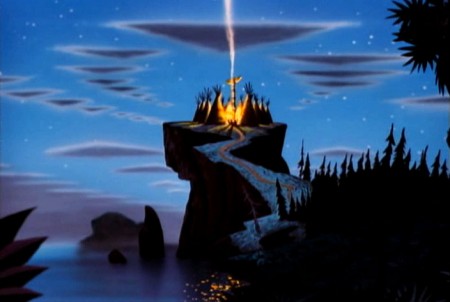
.
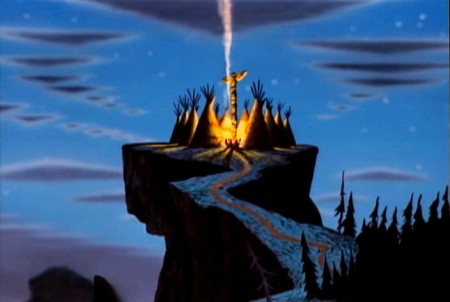
But basically that would seem to be it for the use of the multiplane camera in the film. There’s the one big scene, the flying scene, which shows it off as well as any scene to that point in Disney animation, and a couple of other much smaller scenes.
But on second look we find that there was some use of it in the nursery.
The Bgs contain stripes and obviously brought some concern that there would be strobing, especially in cutting from one set of stripes to another – one CU to another.
It appears to me that they put the Bgs for the closeups out of focus by putting them on a lower level of the multiplane camera and shot the characters in focus. It’s a simple trick (given there were no camera moves) that didn’t up the budget very much.
AfterNote: I am wrong about this. Milt Gray, in the comments section, had proof that the Bgs were painted with Airbrush to soften them.
I’d recently read that they were thinking of utilizing this trick at one point in Cinderella. They ultimately decided against it. (I think it was an interview with Wilfred Jackson, but I haven’t located that reference quickly. When I do, I’ll put the quote in here.)
Here are a number of examples:
 1
1There’s a soft focus on the Bg – not very extreme.
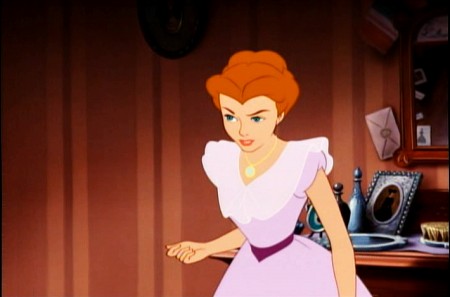 2
2
We go from this half-shot leaving the shot in focus . . .
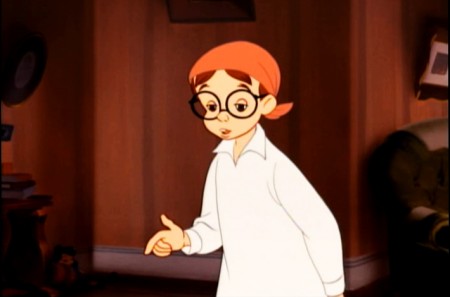 3
3
. . . to this shot of John where the focus is soft.
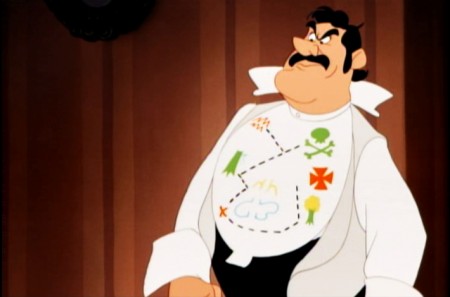 4
4
Father stands, here, with an in-focus Bg.
 6
6
Back to the parents with the Bg still in focus.
 8
8
Now father stands against a very soft Bg.
It probably didn’t work cutting back and forth with the Bgs in focus.
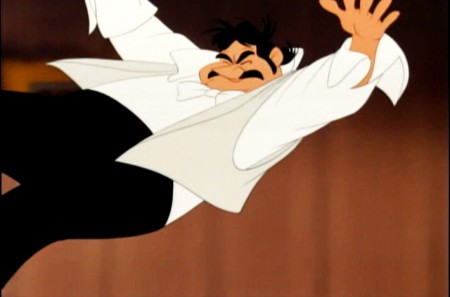 9
9
This scene is the only one with a big camera move as . . .
 10
10
. . . father flies across the room and . . .
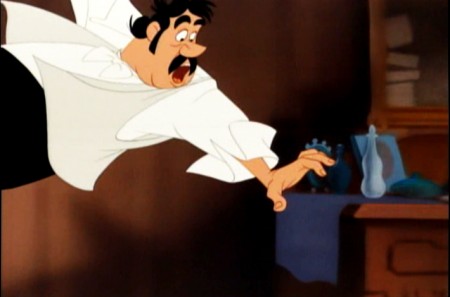 11
11
. . . hits a night table.
The stripes are out of focus. The foreground night table is
in focus, meaning it would be on the same level as father.
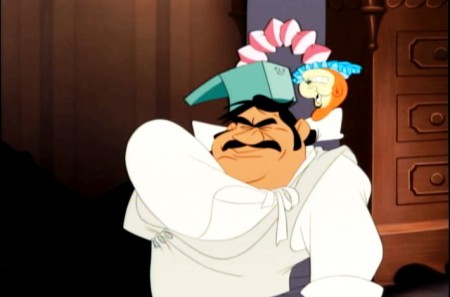 12
12
The finish comes a couple of scenes later. It’s all, now, in focus.
Back in the nursery at the end of the film, the soft focus comes back in two or three short scenes.

This shot of the father is typical of the soft Bgs. They seem to build
from in-focus to getting softer and softer (behind father) as he realizes
that he’s “seen that ship before.”
Many of the other shots at this point are in focus.

I wonder, in this shot, if the ship were on another level so that it would read soft.
This scene has such magic in it, somehow I think they HAD to use the multiplane camera.
Commentary 11 Jun 2011 06:49 am
. . . and more
.

- Terrence Malick‘s new film, The Tree of Life, is far and away my favorite of the year, and it’s hard to imagine another besting it. The film starts with a vision of god that moves beyond to a patriarchal dominated family in Waco, Texas. The suggestion of a death leads us back to god and the creation of the earth. From protozoa to dinosaur to the birth of a child, this filmmaker exudes absolute love for every organism he can show us on screen. Yet, right from the dinosaurs onward he creates an ominous tone in this male-dominated power hungry environment. You’re always expecting something terrible to happen in the hands of the children who push the film forward.
This is a film that technically has a new way of presenting itself almost through an impressionistic vision. The whispered narration and dialogue mix and blend into one; the sun streamed backlit late-afternoon interiors create a whispered visual to match. All of it is driven with a new and unusual way of cutting – first seen in Malick’s last film, The New World.
The film only has big thoughts on its mind, and the director’s absolute love of everything pulls us into a world and an environment that is like no other. It’s a great film. Audiences are finding it thrilling and tedious, too long and brilliant. There are many who love it and many who hate it. I loved it and can only question how I can employ some of these new thoughts and devices for my future films. What an inspiration!
I haven’t stopped thinking about it since I saw it on Tuesday.
.

George Griffin & John Canemaker
.
Independent Animators
I’d written last week about regularly featuring articles on this blog about Independent animators. The first one is almost finished and will be run this coming Tuesday. It’s a conversation with George Griffin, an animator whose work has been something of an inspiration to me over the course of my entire career. It was a pleasure putting this piece together for me, and I think it’ll be worth the read.
- John Canemaker has an Appreciation of Tyrus Wong on the blog of the Disney Family Museum. This is an excerpt from John’s book, Before the Animation Begins.
The Disney Family Museum are celebrating Bambi all month with a number of articles, and it might be well worth keeping a watch on what they’ll post for it.
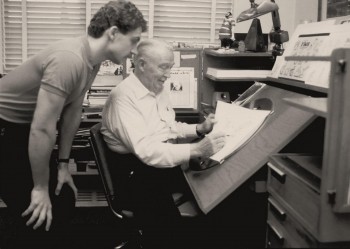 - Surely, by now, most of you know that Andreas Deja has a new blog called, punnily, Deja View.
- Surely, by now, most of you know that Andreas Deja has a new blog called, punnily, Deja View.
If you haven’t visited and are a fan of Disney art, I suggest you check it out. It’s less than a week old, and we’ve already visited Eric Larsen (pictured to the left with Deja), Frank Thomas and Ollie Johnston, Milt Kahl and Marc Davis. The artwork on display ranges from multiple poses of Maleficent to Cinderella and prince dancing, to Pinocchio skipping. We can only assume this material will continue at the same high calibre for a while.
I hope we get some stories and artwork by Andreas Deja, himself, since I have to say his was my favorite animation coming out of the Disney studio in the time he had worked there. It shows how little the studio truly respects animation that they don’t have proper work for a man of his talent. How little respect animation really gets in these days of computerized puppetry.
 - Jeff Katzenberg was interviewed by The Hollywood Reporter about the decline of 3D in movies. In the interview, Mr. Katzenberg had this to say.
- Jeff Katzenberg was interviewed by The Hollywood Reporter about the decline of 3D in movies. In the interview, Mr. Katzenberg had this to say.
THR: Do you have any plans to change your 3D strategy at DreamWorks Animation?
Katzenberg: We’re not the problem. We have made five films now in 3D and have built this amazing reservoir of knowledge and tools. Nobody else has made five 3D movies back to back. You can see the quality of the experience increasing with every film. The cost has gone down significantly for us the last three years, and there is still meaningful, incremental profit to us, even though the size of our audience has narrowed. On every account for us, 3D is a win. It’s not nearly as big a win as it should be, and it’s certainly not the win it was headed toward being, and that’s really heartbreaking to me because we have managed to snatch defeat out of the jaws of victory as only Hollywood can do.
Books &Commentary &Layout & Design &Theater 05 Jun 2011 07:08 am
Boris Aronson & the Yiddish Theater
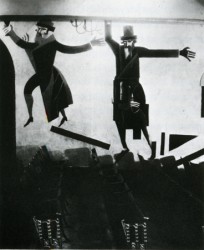 Back in 2007, Eddie Fitzgerald had an excellent piece on his site about the Yiddish Theater. This encouraged me, at the time, to write a post built on the back of some of the set designs of Boris Aronson, one of the greatest of all set designers for Broadway. I’ve added to it and recap it here.
Back in 2007, Eddie Fitzgerald had an excellent piece on his site about the Yiddish Theater. This encouraged me, at the time, to write a post built on the back of some of the set designs of Boris Aronson, one of the greatest of all set designers for Broadway. I’ve added to it and recap it here.
Most people have forgotten the theatrical heritage that came out of the Yiddish Theater. The immigrants to America brought a theatrical treasure with them. In New York, Second Avenue housed dozens of theaters that entertained a very large audience with hundreds of plays. The shows, of course, were all performed in Yiddish. These shows were not only in Manhattan but in the outer boroughs as well.
Many performers stepped out of Yiddish Theater into stardom, but there were also many directors, writers, composers and designers that emerged as well to create the history of the mainstream theater.
Boris Aronson, a Russian immigrant, designed for the Yiddish Unser Theater in the Bronx. He took his position as an opportunity to introduce Constructivist designs to audiences. New art was entering America at the popular level, and it was accepted.
Aronson did quite a number of set pieces and costume designs before moving over to the mainstream, English-speaking theater. He became the foremost designer on Broadway designing the original productions of many shows such as Cabin In The Sky, Bus Stop, The Crucible, and Awake and Sing. His later work included Cabaret, Fiddler On The Roof, Company, Follies and Zorba.
Here are a few examples of the work he did for the Yiddish Theater.
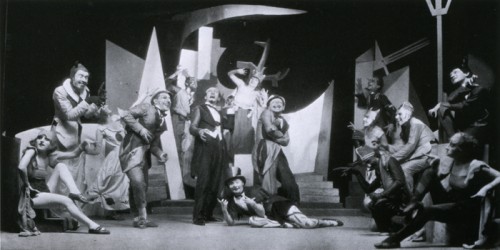
The above three images are from Aronson’s first production.
The Constructivist designs were for Ansky’s production of Day and Night (1924).
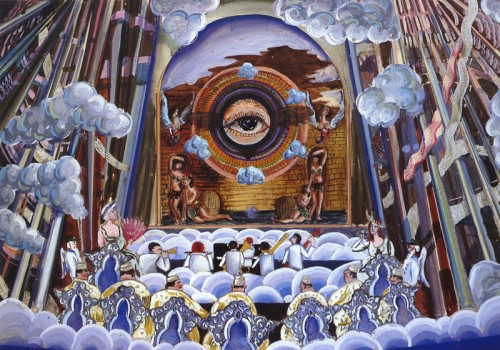
The allegorical plays of the Yiddish theater often featured Heaven and Hell.
Here, Aronson designed a “a concert hall in the skies of hell.”
The show was Maurice Schwartz’ production of “Angels on Earth”
for the Yiddish Theater in 1929.

Here is his depiction of “Hell” in model form.
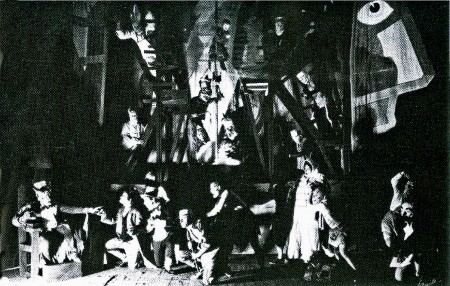
Here is the actual production of the “Hell” set.
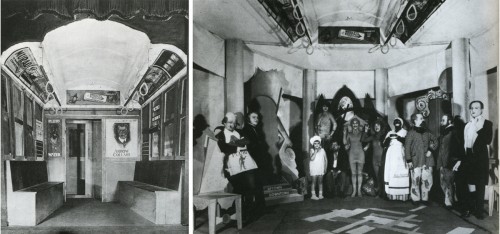
The show “The Bronx Express” required a subway car (left) with advertising cards.
A tired buttonmaker on his way home from work dreams that these ads come to life. (right)
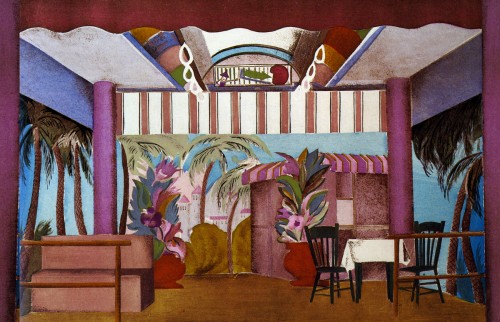
In the same show, the buttonmaker dreams of a beach resort boardwalk.
Aronson keeps the ceiling of the subway car intact for this set.
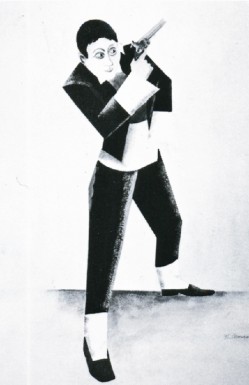
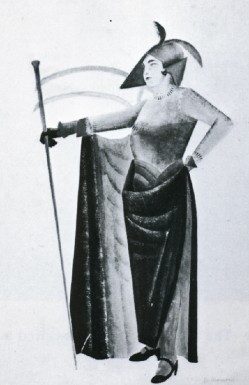
Designs for costumes for Joseph Buloff and Maurice Schwartz.
Books &Commentary &Disney 04 Jun 2011 06:52 am
Don Hahn’s Brainstorm & Other Brickabrack
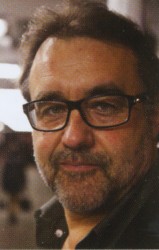 - Don Hahn is a busy guy. Aside from producing Beauty and the Beast, The Lion King and The Hunchback of Notre Dame, he’s produced the Disney nature documentaries Earth, Oceans and African Cats. He’s also directed Waking Sleeping Beauty about the renaissance of Disney animation.
- Don Hahn is a busy guy. Aside from producing Beauty and the Beast, The Lion King and The Hunchback of Notre Dame, he’s produced the Disney nature documentaries Earth, Oceans and African Cats. He’s also directed Waking Sleeping Beauty about the renaissance of Disney animation.
Mr. Hahn has also written a number of books, starting with Animation Magic through Disney’s Animation Kit as well as The Alchemy of Animation up to his most recent (non-picture) book, Brainstorm: Unleashing Your Creative Self.
I recently picked up Brainstorm and have read it, so I thought I’d write a few comments. I believe this is an updated and expanded version of the earlier book, Dancing Corn Dogs in the Night. In either incarnation, it’s an easy-to-read book with a light and casual sense of humor. Mr. Hahn is very comfortable in the skin of the light raconteur; he often tells stories that are witty and help to direct his point. This is a book about the creative process, and it tries to tell people how to get their artistic side out of their bodies.
 This process is best told in a story wherein a younger production manager calls Hahn in the evening asking to come up to his office. When they meet, the young executive says he needs advice: he’s trying to write a screenplay and is stuck. He wants Hahn’s advice as to how to get going. Hahn tells us that “the most successful writers write because they have to.” The conversation, he tells us, really came down to how much the writer “really felt he had to write.” Hahn says that he felt the writer had shortchanged himself; he needed the courage to be honest with himself and make big changes in his career path. “He had to be authentic.”
This process is best told in a story wherein a younger production manager calls Hahn in the evening asking to come up to his office. When they meet, the young executive says he needs advice: he’s trying to write a screenplay and is stuck. He wants Hahn’s advice as to how to get going. Hahn tells us that “the most successful writers write because they have to.” The conversation, he tells us, really came down to how much the writer “really felt he had to write.” Hahn says that he felt the writer had shortchanged himself; he needed the courage to be honest with himself and make big changes in his career path. “He had to be authentic.”
There are many such stories like this in the book, and they all feel authentic. It’s just that they all feel as though they’re adding up to be a Self-help book. There are many lines which I had to squirm through with ideas that no one would really have to tell an artist. The hardest line for me in the book is: “Shakespeare must have loved putting words together. He was like a phrase machine. If one guy was able to be that innovative with language in the sixteenth century, then why can’t we be more innovative?” The answer, of course, is that Shakespeare was the greatest living writer-as-artist that there ever was. He was a genius. I am not a genius, but I would never compare myself with Shakespeare. Maybe Stephen Sondheim might be comparable, but don’t ask me to be innovative so that I can be more like Shakespeare! I think of myself as someone trying my entire life to be an artist; I don’t have a problem being innovative, but I also can’t put myself in the same sentence with Shakespeare.
As such, I had a bit of a hard time reading it. I never in my life have had a hard time expressing myself artistically and have never needed advice on how to allow the muse to flow from myself. I don’t have a hard time getting started; more so I have a hard time stopping.
It was difficult for me to contain myself while reading a how-to book on the artistic process. “Art for Beginners” is not something I really needed to read, however the stories told kept me moving on through the book, and I’m sure they’ll entertain you as well. There’s the story of Dick Williams disappearing from his studio while preparing for a deadline in animating a scene, only to return very late in the deadline to whip it out. He had his own process of preparation. Or there’s the story of meeting Woolie Reitherman for the first time and hearing him call John Huston during the meeting (which leads to Hahn’s casual comparison between Reitherman and Huston.)
There are many stories we haven’t heard before, and for that alone, I felt the book was worth reading. I also appreciated that it might help some people to get the creative process going, if they are novices trying to think of themselves in artistic terms. I assume there are many such people out there.
2000
- This is the 2000th post I’ve put up.
No wonder my typing fingers are sore.
____________________
A Bad Start
 - Things started off roughly this week. First thing in the morning on Tuesday I was greeted with the news that Karen Aqua had died. It took a lot out of me that day. To lose so enormous a talent is difficult; to lose a friend in the animation community is even harder. We lost both with that email.
- Things started off roughly this week. First thing in the morning on Tuesday I was greeted with the news that Karen Aqua had died. It took a lot out of me that day. To lose so enormous a talent is difficult; to lose a friend in the animation community is even harder. We lost both with that email.
I posted my little post – not much more really, than Karen’s husband, Ken Field‘s telling of the news and information about a memorial service (when I know more about that I’ll pass the news on) – , but I found a wealth of Independent animators checking in to express thier feelings. Everyone from Candy Kugel to Kathy Rose, Joanna Priestly to Paul Glabicki. _____________Civilization by Karen Aqua
I realized with that open expression that there really is no place for the Independent animator to check in for news or stories about their work. Non studio artists are left to their own blogs and websites to promote their animation while multi-mega-budget films are given top headlines over whether or not they’ve broken the $100 million mark. It just doesn’t seem fair to me.
So I’ve decided to step tentatively into this water. I’m going to devote a day of the week (probably Tuesday or Thursday) to writing about some filmmaker/artist/animator. It’ll probably be a mix of reviews, interviews and bios of some of our best artists. Shameless promotion for the films that deserve more attention.
Independent animators: don’t hesitate to contact me if you have anything you’d like to promote or news you’d like to share or even if you’re just interested in having your films be a focus for a day.
- Speaking about that post, I was glad to see Cartoon Brew finally comment on Karen’s passing by directing people to my blog, but I was annoyed to see another blog lift my piece verbatim and post it on their site – not even separating my stills from their enlarged versions so that when you clicked a still it sent you to my site. Ordinarily, I wouldn’t mind, but I do like when they give my blog credit. Unfortunately, there was no naming of the origination of this post, and the blogger passed it off as if it were his own.
People, we have to have some modicum of courtesy out there !
I also contacted Ron Diamond at AWN to make sure they’d have a note about Karen on their site, (I knew they would, they’re usually just a tad slow in getting it done) and, indeed, they said one was in the works. It was posted that same day.
- The Holland Animation Film Festival has made a decision to move its date from Autumn to Spring. That means their next Festival will take place in the Spring of 2012, and there will be no Holland Animation Festival in 2011. The next edition is from 28 March through 1 April 2012.
I haven’t attended any of their Festivals, but for some reason I suspect this is one of the better ones out there. Maybe I should aim to go in 2012 if I can ever finish another film.
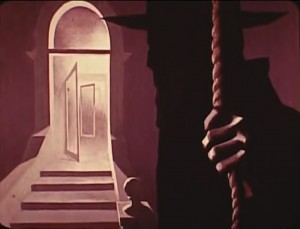 - Hans Bacher has posted a number of beautiful posts on Paul Julian‘s work on The Hangman, a film he directed in 1964. Go here and here to see the two already up and they will lead you to past posts on Julian’s work.
- Hans Bacher has posted a number of beautiful posts on Paul Julian‘s work on The Hangman, a film he directed in 1964. Go here and here to see the two already up and they will lead you to past posts on Julian’s work.
In the past, I’ve posted a couple of Julian’s books, Toot and Piccoli.
I’ve also done posts about Paul Julian‘s work for Roger Corman. You can see those posts here.
You can see a reddish print on YouTube here.
Commentary &Independent Animation 31 May 2011 06:47 am
Karen Aqua 1954-2011
- I woke up to a very sad email from Lisa Crafts, this morning. She sent the news that the brilliant and Independent animator, Karen Aqua, had passed away. Here’s Lisa’s note:
 I am sorry to write this in an email, but thought you would want to know.
I am sorry to write this in an email, but thought you would want to know.Karen died peacefully today after a 10 year battle with cancer.
In her last month, Karen managed to finish her film Taxonomy, premiere it at the Boston Institute of Contemporary Art, and was named a 2011 Fellow in Film & Video by the Massachusetts Cultural Council.
Her warm and ebullient spirit, dedication to animation, (and wild clothes) will be missed by all.
with love,
Lisa
And with that she attached a letter from Karen’s husband, Ken Field.
 It is with great great sadness that I must report that our dearest Karen died peacefully at Brigham & Women’s Hospital late this afternoon.
It is with great great sadness that I must report that our dearest Karen died peacefully at Brigham & Women’s Hospital late this afternoon.
She had extreme difficultly breathing Saturday morning at the Cape, and we came back a day early and brought her directly to the emergency room. She had a rapid decline since then, and was on a morphine drip and other pain medications when she died.
She was so happy that we made it to the Cape for a few days, her final wish, and that she got to wiggle her toes in the water on the beach, among a long long list of other accomplishments since her initial cancer diagnosis in 2001.
Karen will be cremated. She has asked that her ashes be distributed to a number of places that were meaningful and dear to us, including New Orleans, Hawaii, Roswell, Italy, and of course Cambridge.
A memorial tribute will be held on Sunday, July 10 at 2pm at Arts at the Armory, 191 Highland Avenue in Somerville, MA.
With all best wishes, and with continued gratitude for your wishes and support, and with lots of love,
-Ken
I don’t have much more to say. Karen was a bright spot shining out of Cambridge. I saw her infrequently, but somehow I felt close to her. Whenever we met up it was all smiles. At the very least, I felt close to her films. This is sad for me.
Commentary &Photos 29 May 2011 08:18 am
Caged Birds Sing
- Everyone thinks of New York as made of steel, glass and concrete. If you try to add Trees to that mix, people would look at you querulously. Except for the center of the city, from 42nd to 59th Streets, from Park to Eighth Avenues, you’ll find trees.
But, I thinik, the trees pay some kind of price. The plot of ground into which they’re planted is dressed wholly by the owner of the buildings they grace. Let’s take a look at the cages that are built for trees in the city of concrete, glass and steel.
 1
1This is a picture of my block taken this week. You can see how lush
it appears to be, and we have to go in closer to see the planters.
 2
2
Here’s the base of the tree right outside the brownstone I live in.
No dressing. Just a square hole cut into the ground with the
tree’s roots hidden beneath the earth.
 3
3
Here’s what a building not too far away from us is using.
A wrought iron cage with lots of additional shrubbery. The
cage keeps animals away from the tree so they don’t kill it.
 4
4
If you step back you can get a good look at
the tree in, what works as a natural environment.
 5
5
But then here’s a tree just outside a park. They don’t give
the tree much breathing space in the concrete. And this is
how all the trees surrounding the park are dressed.
 6
6
It’s probably better than this. It looks different, but
I’m not sure trees were designed to grow through shale.
 7
7
Here’s a closer look at the rock bed at the foot of this tree.
 8
8
Within view of J.C.Penney on 32nd St, this building has chosen
to give more space to the trees out front. A longer plot of soil.
 9
9
They’re only fenced in on the pedestrian’s side of the fence.
But you can see the new growth coming up alongside the tree.
(I think it likes the soil to stretch its roots. I wonder how it deals
with the cigarette butts. Smokers have found a convenient ash tray.)
 10
10
In another box outside this building, they’ve planted flowers.
 11
11
This building has chosen something other than an iron fence.
 12
12
They’ve gone woody, and have added lots of shrubbery.
 13
13
Some buildings don’t even PLANT the trees.
They place them in decorative barrels, allowing them to be moved.
 14
14
This building has added plenty of ivy to the mix.
 15
15
This is the course the City has taken near Madison Square Park.
They’ve cut into the 23rd Street traffic by constructing a place for
pedestrians to sit – in the middle of traffic. The City tries to make it
habitable by adding plenty of foliage planted in planters that can be moved.
 16
16
The trees don’t seem to be complaining, and it is a bit attractive.
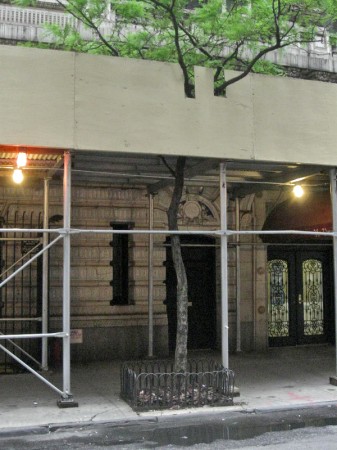 17
17
This construction site is trying to make the best for
the tree outside their hostile attack on the building.
They’ve cut around their scaffolding to accomodate the tree.
 18
18
I’m sure it’ll be a glorious summer for this tree.
 19
19
Not too different from the decoration around this tree’s base – bricks.
 20
20
The bricks move in around the plot beneath this tree
right up to a very tight and tall iron fence.
 21
21
Of course, the trash only sits within the fence disgracing the tree.
 22
22
Madison Avenue tries to be a bit more graceful for their trees.
 23
23
A designer wrought iron grill with some delicate plants within the soil.
 24
24
But only a block away, still on Madison Ave, the grill
takes up any square inch of the tree’s breathing room.
 25
25
Here’s another one with the grill shabbily designed to cover all
the dirt within the plot. It goes right up to the base of the tree.
 26
26
Yet, step back in the sun, and the tree looks to be thriving
in the middle of a congested area in Greenwich Village.
 27
27
Finally, Here’s an image Steve Fisher took a while ago to add to the collection.*
One wonders if the City had regulated what could be constructed about the edges of the trees. Would that have a better designed fencing for the trees? Would that actually be worse, in that there IS the chance that a building owner will do well by the tree? I can’t answer; I can just see what’s there – a grab-bag of fenestration designed to prevent urinating animals away from the trees. But they’re not always the best. I look, again, at what’s outside my building. (#2) The hole left by the City’s planters hasn’t been touched by my building’s owners. Let me say it seems serviceable as compared to the grill in the Village. (#25-26)
In the end, I have to say that I’m just glad to have the tree. Especially at this time of year.
* Steve Fisher also sent this link to the regulations on such plots for trees on the books for NYC.
